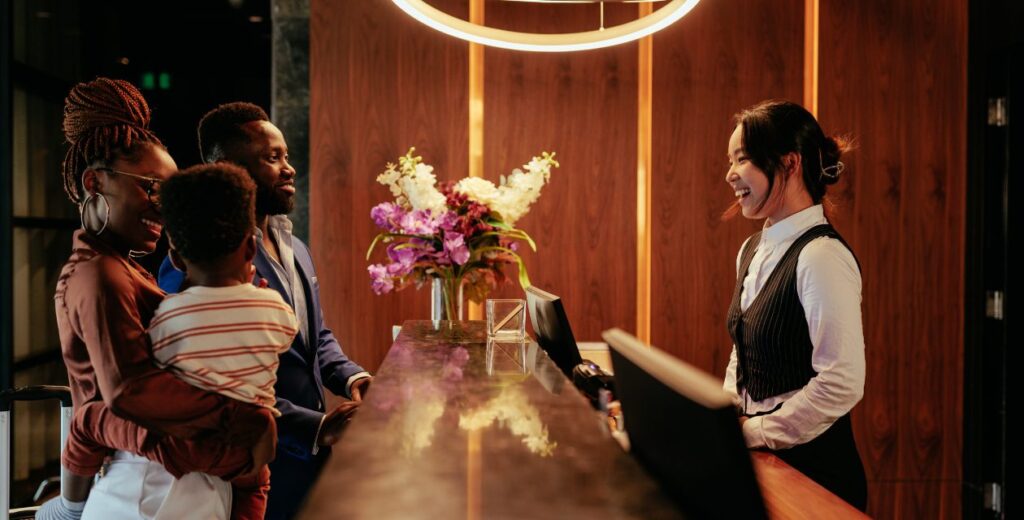Top social platforms in APAC for hoteliers
A hotelier's guide to the top social platforms in Asia-Pacific
Asia already boasts over 2 billion mobile internet users, of which 61% are smartphone connections. That means that smartphones have become the primary means for accessing the internet for the billion-plus people who use smartphones to connect with friends on social networks, pay for goods and services, book travel, manage their finances, order food for delivery and so much more.
Asia Pacific’s rapid rate of mobile adoption has led the region to leapfrog past desktops and rely on mobile phones for nearly everything. The smartphone’s growing role in everyday life is why social media platforms play a critical role in engaging with both business and leisure travelers in Asia.
In fact, social media is even more important in Asia than elsewhere due to the prominence of “super apps” that bring together social networking, multimedia content, messaging, and eCommerce into a single platform.
With these “one-stop-shop” social networks, travelers can find inspiration, research destinations, and book travel all in a single spot. It’s no wonder that mobile bookings are far more prevalent in APAC than elsewhere in the world. In just two years, Phocuswright estimated that mobile’s share of bookings in the region exploded from 44% in 2017 to a projected 55% in 2019 — far outpacing the U.S. and Europe.
So where should you be investing your marketing dollars and social media resources to most effectively target travelers who have not yet established loyalty relationships with hospitality brands? This quick reference guide walks you through the top social networks in Asia for hoteliers, so that you can be present on the platforms that your guests prefer.
Of course, Facebook, WhatsApp, and Instagram enjoy similar penetration and popularity in many Asia-Pacific markets, especially in markets including Australia, Japan, and Singapore (except in China, where they are banned). Since those are the most well-known networks, we’ll focus more on other networks so you can craft a social strategy for Asia that connects your brand with Asia’s next generation of travelers.
WeChat is the most widely-used “super app” in China. Created by Shenzhen-based internet giant Tencent, Weixin (literally “micro message”), WeChat is the go-to communication app for business and leisure for over 1.15 billion monthly users. The bulk of these users are in China, as well as India and elsewhere in Southeast Asia. Growth is also starting to pick up in Latin America, although there are very few users in Europe and North America.
Available in both English and Chinese, WeChat is fully entrenched in the lives of its users. Where once business people exchanged business cards as an expression of recognition and respect during any meeting in China, it is now far more common for one person to ask to scan the other’s QR code (the junior person always does the scanning, as the senior person may then approve or reject the request to connect).
For hotels looking to engage with Chinese travelers — especially millennials — WeChat is a must, says Bruce McKenzie, SVP of operations in Greater China and Mongolia for Hilton Worldwide Holdings told HotelNewsNow,
“Our WeChat service account users are generally younger millennials, the tech-savvy and business travelers. But WeChat’s ubiquity in China means that we see WeChat use across a wide range of Hilton customer demographics.”
Key features:
- Moments: WeChat’s social function, is similar to a person’s Facebook Wall, although a user’s post may only be seen by those who are connected to the user. The poster may respond to comments by others, but those other users will not see the comments if they are not connected to the third person.
- Newsletters: WeChat’s newsletter publishing function allows commercial users to publish and send regular updates on an opt-in only basis. Newsletters are grouped under a section called “Subscriptions” and are less intrusive than short messaging service (SMS) or email. Often companies require users to scan and subscribe to their WeChat newsletter in order to earn a discount or use a free service, such as guest Wi-Fi.
- Mini-programs: Mini programs are like websites or stores embedded within WeChat. Hotels can pull together property info, menus, and bookings into a mini-program so the user does not have to leave the app. Users can browse mini-programs and discover new brands easily. For hotels, mini-programs foster a direct connection between content and commerce.
- Payments: WeChat Pay enables seamless digital payments both online and offline, with QR codes populating taxis, restaurants, and cashiers all over China (and abroad).
- Channels: The newest feature, available via the Discovery tab, allows users to explore media accounts from users outside their contacts. Users can now post short videos under 1 minute to share publicly on those channels.
With over 800 million monthly active users in over 80 countries, QQ is the fourth biggest global messaging app. Also owned by Tencent, this is primarily a messaging app whereas WeChat has become more of a “super app” with more full-featured commerce applications. QQ also skews younger (think Gen Z), while WeChat has more of a mainstream demographic appeal across generations.
While there may not be many direct commercial features of QQ, this is another example of a popular messaging app where guests may want to connect and communicate with your hotel. Having a QQ number (the unique number given to each QQ user) ensures that your hotel is available to guests for questions, comments, and concerns.
Other features:
- QZone: QZone is where users can share content with their networks, as well as access more information from businesses and other public accounts. Similar to WeChat Moments, except that a user’s entire friend list can see the discussion and comments publicly.
- App Store: A standalone app store connects users to gaming, news, and entertainment.
- Chat translation: QQ will translate your chats from language to another so that you can communicate across language much more easily.
- Payments: QQ payments are limited to in-app purchases by users and don’t have a real-world payment application for businesses.
TikTok
One of the newest entrants to the social networking space is also one of the most popular: TikTok, a social network based on short and incredibly creative mobile videos. TikTok has taken over the world with 800 million users, making it the 7th most popular social network in the world and the most downloaded app in over 40 countries.
TikTok is entirely different than the other social platforms. Rather than being based on friend groups or other closed networks, the platform is entirely driven by an algorithm. So, rather than discovering content that friends like, the content discovery journey is driven by an algorithm that considers wider platform trends and each user’s own individual behavior.
This “black box” aspect makes it quite challenging for hotels to capture reliable engagement and measure return on investment. Nonetheless, When done well, it’s an excellent opportunity to gain mindshare in a new and growing community. For hotels, the primary way to use the platform is to create content targeted to this younger user base.
While it’s certainly not the best fit for most brands, certain boutiques and other younger-leaning brands have a massive opportunity to stand out on this platform when there are still relatively few businesses investing resources. This is an ideal time for brands to experiment with the platform, as early-mover brands have greater chances of success before the platform becomes heavily monetized.
Features:
- Hashtag challenge: Any user can create a hashtag challenge around a specific task. users are encouraged to tackle the challenge and post with the associated hashtag. While it’s hard to get exactly right, a hashtag challenge can deliver a massive boost to a brand that generates enthusiasm and excitement.
- TikTok Ads: Since Tik Tok is actually popular across the world, its ad platform provides a massive Bass for targeting. With immersive mobile-only formats, hotels with a focus on creativity and authenticity will find a wealth of opportunities that stretch across TikTok’s portfolio of apps.
- “Shoppable” ads: TikTok has also recently begun to test ways to more closely align commerce with its content. Brands will soon be able to attach a URL to their advertising videos so that users can swipe up to purchase the good or service being advertised.
- Influencers: Similar to Instagram, TikTok is driven by influencers. Those users that attract large followings become celebrities in their own right
LINE
LINE is Japan’s most popular social networking application, with 82 million monthly active users. It’s also the second-most popular Asia-based mobile messenger, with 164 million monthly active users, of which 79% actually use the app daily. About half of LINE’s user base is outside of Japan, including in Taiwan and Thailand, where it is the most popular messaging app, and Indonesia, where it is the second most popular messaging app.
LINE features include private messaging, sharing pictures, music, gaming and posting moments in a timeline, as well as other “super app” functionality, such as ordering food, hailing taxis, and listening to music.
Other key features:
- Timeline: This is where users share content, such as text, images, and videos, with friends and family.
- Stickers: LINE is especially known for its active sticker culture. The stickers have become a major business for the company, with licensing and company-sponsored sticker packs sold to users. For creative hotel marketers, these stickers can be a clever and effective way to market on the platform.
- Payments: LINE Pay is a peer-to-peer payments network for paying others (and businesses) via the app. LINE Also recently announced an AI-driven social credit system
- Mini-apps: Similar to WeChat mini-programs, these mini-apps allow companies to host pared-down versions of their own apps within LINE so that users can purchase goods and services without leaving the app.
Developed by China internet pioneer Sina, Weibo is sometimes referred to as “China’s Twitter.” It performs a similar microblogging “one to many ” function, where Individuals and businesses can broadcast relevant content, events, and offers to a large number of users, both followers and non-followers.
Prior to the launch of WeChat, Weibo was China’s leading social tool. Although WeChat is more personalized, Weibo’s public nature still has broad appeal for both the user and businesses looking to engage new and repeat customers. Weibo is less intrusive than email as it requires user opt-in to follow.
Also, a user’s Weibo profile can also potentially be scraped or analyzed for preferences, such as with Cendyn’s CRM platform that pulls a user’s Weibo into their guest profile, providing the hotel brand with a single source for deeper insight into the guest and their preferences.
Key features:
- Profile: Each user has a centralized profile that shows the latest messages, comments, and other interactions. This is your hotel’s primary footprint on Weibo.
- Responses/forwards: Messages can be forwarded or replied, similar to a “retweet”; and can also be read by non-followers looking for offers or other promotions.
- Direct messages: Users can message each other directly.
Mafengwo
Started in 2010, Mafengwo is a social network exclusively for travelers. With over 100 million active users, the platform combines long-form travel content with bookable travel inventory, from travel packages to ground transportation, hotels and local tours. Think of it as a content-forward OTA with a social networking backbone that influences traveler decisions.
Currently, Mafengwo has over 1 million user-generated travel guides that offer first-hand reviews and authentic perspectives on where to go and what to do. The social network leverages the trend towards fewer group trips and more independently booked trips by outbound Chinese tourists. These travelers prefer to make their own arrangements and figure out what to do while traveling abroad and turn to Mafengwo for inspiration and bookings.
Features:
- Blogging: Users can create their own blogs to share their own journeys. These are often in the form of itineraries, which outline a user’s recommendations for a given trip.
- Comments and voting: Engagement is driven primarily through comments and voting, where users can comment and up/downvote content posted by others.
- Influencers: Mafengwo has similar characteristics to Instagram insofar as the central role of influencers. By identifying micro-influencers that speak to similar demographics as your hotel, you can build an influencer marketing campaign that puts your hotel in front of relevant audiences and helps you build your brand.





